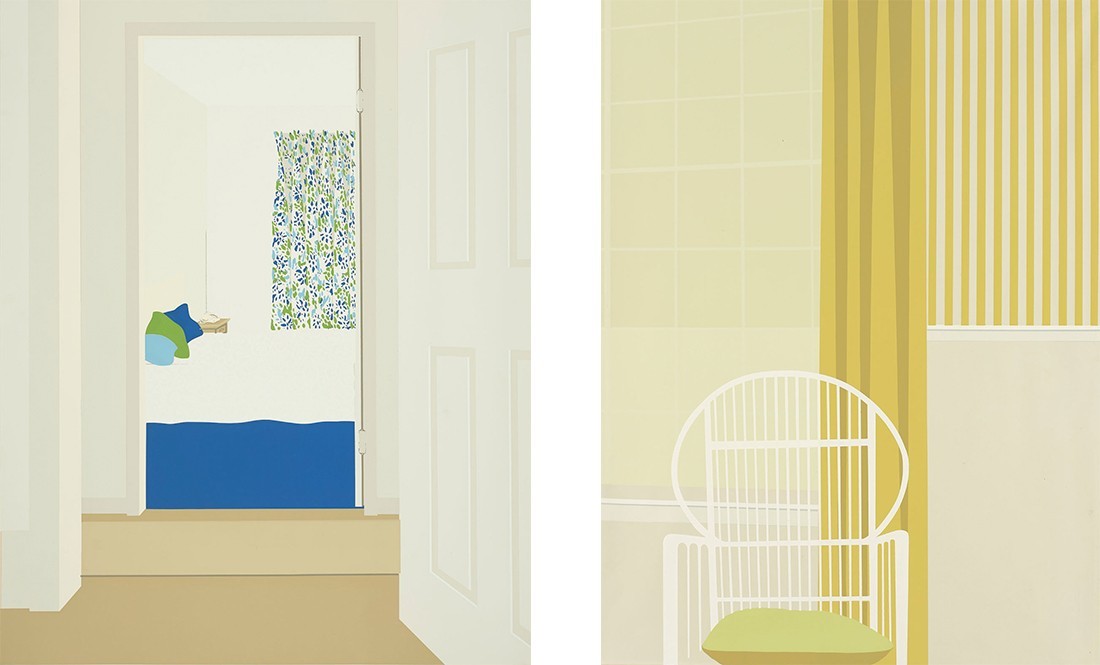Studies of Vacancy
Kim Ondaatje and the House on Piccadilly Street
Inspired by her rambling Victorian home in London, Ontario, Kim Ondaatje’s serigraph series “The House on Piccadilly Street” embodies both the serenity and the malaise of being homebound. Providing glimpses of spare, unpeopled rooms, the prints portray a detached domesticity, void of intimate details yet rife with potential.
In the winter of 2020, the Art Gallery of Ontario purchased six works from the series to complement the one it already owned, Doors, acquired in 1972. The gallery now holds the complete set of seven prints, and plans to exhibit them next year in celebration of Ondaatje’s remarkable contribution to Canadian art. Despite being produced more than 50 years ago, the prints, with their hard edges and muted palette, feel very contemporary. No one could have predicted just how contemporary they would feel in the face of a global pandemic.
By spring 2020, terms like “self-isolation” and “physical distancing” entered everyday parlance, and the “Piccadilly” prints became increasingly potent. Their dream-like sensibility aptly reflected the melancholia of our new reality. Hall, a view of three doorways at the end of a sparse corridor, embodied the disorientation I felt after spending 23 hours a day inside my apartment. Cuckoo Clock, with its kitschy timepiece seen through a mirror on canary-yellow striped wallpaper, turned the entire notion of temporality on its head, which, in my unsettled state, had me continually forgetting which day of the week it was.
Summer came, and as the world continued to grieve the loss of normalcy, the “Piccadilly” prints engrained themselves deeper into my psyche. To learn about the context in which they were made, I visited Kim Ondaatje at her home in Verona, just north of Kingston. Approaching the long gravel driveway, I immediately understood the extent to which “home” is a central concept for the artist. Her residence, Blueroof Farm, is a lush and sprawling idyll, referred to by Ondaatje in her exhibition catalogue for Museum London in 2013 as her longest running project, “a performance work done in three dimensions.” For over 40 years she has cared for the property and its surrounding acres of ponds, wildflowers and farm fields. The house and outbuildings are topped with brilliant cobalt-blue metal roofs. Remarkably, the farm is the opposite of the austere home depicted in the screen prints.

Left: Blue Bedroom (or “Bedroom”), 1970, silkscreen on paper, 30 x 24 inches. Right: Chair, 1969, silkscreen on paper, 32 x 24 inches.
Once a hockey player, forest ranger, teacher and Dalmatian breeder, Ondaatje, who is a mother of six, has lived a life that wouldn’t be described as calm. Why, then, do the “Piccadilly” prints radiate such quietude? She explained that the views of her London house were captured in a moment of transition. Her husband at the time, writer Michael Ondaatje, had accepted a teaching position at the University of Western Ontario in 1967. They’d rented the house on Piccadilly Street and, before moving in, had the interior cleaned and painted white; the walls had been gashed with holes and layered with grime and dust, which triggered her children’s asthma. “The House on Piccadilly Street” series, therefore, does not depict the house as lived in but as it was after having been refreshed between tenants. The prints, careful and deliberate in their construction, present a liminal space, hovering between old and new, unfamiliar and familiar.
Captivated by this blank slate of potential, Kim Ondaatje made sketches and took hundreds of photographs of the interior. The inner workings of the late 19th-century building were catalytic. Using her sketches and photographs as source material, she painted in the early mornings, using acrylic for the first time in her career. Initially she began working in an attic studio three houses down, where between 1967 and 1969 she produced 12 large-scale “Piccadilly” paintings before opening up the series to include prints. Describing the process of translating the paintings into prints, Ondaatje explained, “Like an author who writes a novel or short story and then later writes an adaptation of the story for the stage and still later writes a film script based on the same story, I enjoy exploring different mediums which enable me to produce more than one version of an experience. So far the initial work has always been a painting, which may be followed at some later day by a large serigraph and still later by a small litho. This is how the House on Piccadilly Street series has developed.” (This comment by the artist was accessed in the Withrow correspondence file at the Edward P Taylor Library & Archives at the Art Gallery of Ontario.)
Redrawing and scaling down the compositions of the seven paintings she felt were the strongest, she produced the first edition of screen prints with a local printer, Steven’s Signs. While the towering dimensions of the paintings give them an immersive quality, the prints are more intimate, with an enigmatic flatness that plays with perspective and perhaps hints at surrealism.
On a conceptual level, “The House on Piccadilly Street” works are complex ruminations on the psychological aspects of domestic space. Doors and Blue Bedroom portray continuous realms that enable imagined wanderings through the house. Ondaatje employed connective furnishings—doors, windows, curtains, archways—to allude to a potential elsewhere; however, there are no clues as to what is going on beyond these rooms. Notably, there is an exclusion of the exterior world: we don’t know what time of day it is, what season.
…to continue reading the article on Kim Ondaatje and the House on Picadilly Street, order a copy of Issue #155 here, or Subscribe today.

